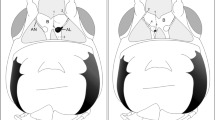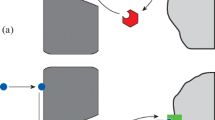Summary
A sensillum in a narrow pit with a broad cuticular collar, located in a sensillum field on the 12th segment of the antennae of Carausius morosus, was investigated electrophysiologically. After marking, it was also examined with the transmission and the scanning electron microscopes. The number of sensory cells within the sensillum varies between three and four. One cell, present in half of the sensilla studied, exhibits a simple cilium of the 9×2+0 type as outer dendritic segment. The outer segment of a second unit is noteworthy in that it divides near its ciliary base into two branches. These flatten to form lamellae, then fold and wrap around each other. The remaining two sensory cells bear unbranched or bifurcate outer segments which contain densely packed microtubules. Only these outer segments extend into the cuticular peg; the others end beneath its base. The cuticular peg is devoid of pore systems. Electrophysiological recording yielded evidence that a cold, a dry and a moist air receptor are present. The fourth unit did not respond clearly to stimulation.
Similar content being viewed by others
References
Altner, H.: Insektensensillen: Bau-und Funktionsprinzipien. Verh. dtsch. Zool. Ges. 70, 139–153 (1977)
Altner, H.: Insect sensillum specificity and structure: an approach to a new typology. In: Olfaction and taste VI (J. LeMagnen, P. MacLeod, eds.), pp. 295–303. London: Information Retrieval 1977
Altner, H., Ernst, K.-D., Kolnberger, I., Loftus, R.: Feinstruktur und adäquater Reiz bei Insektensensillen mit Wandporen. Verh. dtsch. Zool. Ges. 66, 48–53 (1973)
Altner, H., Sass, H., Altner, I.: Relationship between structure and function of antennal chemo-, hygro-, and thermoreceptive sensilla in Periplaneta americana. Cell Tiss. Res. 176, 389–405 (1977)
Altner, H., Thies, G.: A functional unit consisting of an eversible gland with neurosecretory innervation and a proprioreceptor derived from a complex sensillum in an insect. Z. Zellforsch. 145, 503–519 (1973)
Bernard, J. : Étude électrophysiologique de récepteurs impliqués dans l'orientation vers l'hôte et dans l'acte hémophage chez un Hémiptère: Triatoma infestans. Thèse, Université de Rennes, 1-285, Rennes 1974
Bernard, J., Pinet, J.M., Boistel, J.: Électrophysiologie des récepteurs des stylets maxillaires de Triatoma infestans ⊕ction de la température et de la teneur en eau de l'air. J. Insect Physiol. 16, 2157–2180 (1970)
Burkhardt, D.: Allgemeine Sinnesphysiologie und Elektrophysiologie der Receptoren. Fortschr. Zool. 13, 146–189 (1961)
Cappe de Baillon, P.: La sensibilité thermique des Phasmidae. C.R. Acad. Sci. (Paris) 195, 557–559 (1932)
Cappe de Baillon, P.: L'organe antennaire des phasmes. Bull. Biol. France Belg. 70, 1–35 (1936)
Chu-Wang, I-Wu, Axtell, R.C.: Fine structure of the terminal organ of the house fly larva Musca domestica L.. Z. Zellforsch. 127, 287–305 (1972)
Chu-Wang, I-Wu, Axtell, R.C., Kline, D.L.: Antennal and palpal sensilla of the sand fly Culicoides furens (Poey) (Diptera: Ceratopogonidae). Int. J. Insect Morphol. Embryol. 4, 131–149 (1975)
Corbière-Tichané, G.: Structure nerveuse énigmatique dans l'antenne de la larve du Speophyes lucidulus Delar. (Coléoptère cavernicole de la sous-famille des Bathysciinae). J. Microscopie 10, 191–202 (1971)
Corbière-Tichané, G.: Sur les structures sensorielles et leurs fonctions chez la larve de Speophyes lucidulus. Ann. Spéléol. 28, 247–265 (1973)
Corbière-Tichané, G.: Fine structure of an antennal sensory organ (“vésicule olfactive”) of Speophyes lucidulus Delar. (Cave Coleoptera of the Bathysciinae subfamily). Tissue and Cell 6, 535–550 (1974a)
Corbière-Tichané, G.: Sur la presence possible d'un pigment visuel dans un récepteur sensoriel de l'antenne d'un coléoptère cavernicole Speophyes lucidulus Delar. (Bathysciinae). Vision Res. 14, 819–822 (1974b)
Corbière-Tichané, G.: Étude comparative au microscope électronique de la “vésicule olfactive” des Catopidae cavernicoles (Coléoptères). Ann. Sci. Nat. Zool. Paris ser. 12, 19, 89–110 (1977)
Corbière-Tichané, G., Bermond, N.: Sensilles énigmatiques de l'antenne de certains Coléoptères. Z. Zellforsch. 127, 9–33 (1972)
Davis, E.E., Sokolove, Ph.G.: Temperature responses of antennal receptors of the mosquito, Aedes aegypti. J. comp. Physiol. 96, 223–236 (1975)
Ernst, K.-D.: Die Feinstruktur von Riechsensillen auf der Antenne des Aaskäfers Necrophorus (Coleoptera). Z. Zellforsch. 94, 72–102 (1969)
Kafka, W.A.: Molekulare Wechselwirkungen bei der Erregung einzelner Riechzellen. Z. vergl. Physiol. 70, 105–143 (1970)
Lacher, V.: Elektrophysiologische Untersuchungen an einzelnen Rezeptoren für Geruch, Kohlendioxyd, Luftfeuchtigkeit und Temperatur auf den Antennen der Arbeitsbiene und der Drohne (Apis mellifica L.). Z. vergl. Physiol. 48, 587–623 (1964)
Loftus, R.: The response of the antennal cold receptor of Periplaneta americana to rapid temperature changes and to steady temperature. Z. vergl. Physiol. 59, 413–455 (1968)
Loftus, R.: Temperature-dependent dry receptor on antenna of Periplaneta. Tonic Response. J. comp. Physiol. 111, 153–170 (1976)
McIver,: Fine structure of pegs on the palps of female culicine mosquitoes. Canad. J. Zool. 50, 571–576 (1972)
McIver, S.B.: Fine structure of antennal sensilla coeloconica of culicine mosquitoes. Tissue and Cell 5, 105–112 (1973)
McIver, S., Siemicki, R.: Fine structure of the antennal tip of the crabhole mosquito, Deinocerites cancer (Diptera: Culicidae). Int. J. Insect Morphol. Embryol. 5, 319–334 (1976)
Sass, H.: Zur nervösen Codierung von Geruchsreizen bei Periplaneta americana. J. comp. Physiol. 107, 49–65 (1976)
Schafer, R., Sanchez, Th.V.: Antennal sensory system of the cockroach, Periplaneta americana: Postembryonic development and morphology of the sense organs. J. comp. Neurol. 149, 335–354 (1973)
Schaller, D.: Antennal sensory system of Periplaneta americana L.: distribution and frequency of morphologically different sensillum types and their sex-specific changes during post-embryonic development. Cell Tiss. Res. (1978) (in press)
Slifer, E.H.: Sense organs on the antennal flagellum of a walkingstick Carausius morosus Brunner (Phasmida). J. Morph. 120, 189–202 (1966)
Steinbrecht, R.A.: Comparative morphology of olfactory receptors. Olfaction and Taste III (C. Pfaffmann, ed.), pp. 3–21. New York: Rockefeller Univ. Press 1969
Steinbrecht, R.A., Müller, B.: On the stimulus conducting structures in insect olfactory receptors. Z. Zellforsch. 117, 570–575 (1971)
Steinbrecht, R.A., Müller, B.: Fine structure of the antennal receptors of the bed bug, Cimex lectularius L. Tissue and Cell 8, 615–636 (1976)
Tichy, H.: Unusual fine structure of sensory hair triad of the millipede, Polyxenus. Cell Tiss. Res. 156, 229–238 (1975)
Waldow, U.: Elektrophysiologische Untersuchungen an Feuchte-, Trockenund Kälterezeptoren auf der Antenne der Wanderheuschrecke Locusta. Z. vergl. Physiol. 69, 249–283 (1970)
Weide, W.: Einige Bemerkungen über die antennalen Sensillen sowie über das Fühlerwachstum der Stabheuschrecke Carausius (Dixippus) morosus Br. (Insecta: Phasmida). Wiss. Z. Univ. Halle Math. Nat. 9, 247–250 (1960)
Winston, P.W., Green, C.C.: Humidity responses from antennae of the cockroach Leucophaea maderae. Naturwissenschaften 54, 499 (1967)
Yokohari, F., Tateda, H.: Moist and dry hygroreceptors for relative humidity of the cockroach, Periplaneta americana L. J. comp. Physiol. 106, 137–152 (1976)
Yokohari, F., Tominaga, Y., Ando, M., Tateda, H.: An antennal hygroreceptive sensillum of the cockroach. J. Electron Micr. 24, 291–293 (1975)
Author information
Authors and Affiliations
Additional information
Supported by the Deutsche Forschungsgemeinschaft (Al 56/6)
Research Fellow of the Alexander von Humboldt Foundation
Rights and permissions
About this article
Cite this article
Altner, H., Tichy, H. & Altner, I. Lamellated outer dendritic segments of a sensory cell within a poreless thermo- and hygroreceptive sensillum of the insect Carausius morosus . Cell Tissue Res. 191, 287–304 (1978). https://doi.org/10.1007/BF00222425
Accepted:
Issue Date:
DOI: https://doi.org/10.1007/BF00222425




